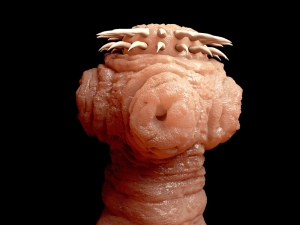Introduction
Tapeworms are usually living in the hosts gut and they have three parts to their anatomy: a head (scolex), a neck and the segments (called “proglottids“, which is mentioned in this review of the dog tapeworm). The head has a suction device or a hook with which it attaches to the inside of the gut, typically in the small intestine.
There is one tapeworm, where the host is the dog and man becomes the intermediate host (target of tissue invasion by the larvae stage) and “hydatid cysts” are found in the liver and in the lungs. This is called hydatid disease. With the pork tapeworm the adult tapeworm can occur in the gut of man after eating raw meat with the storage form (called”cysticerci“) of Taenia solium. When eggs of T. solium are ingested, for instance from infestation of water, humans become intermediate hosts and the disease, called cysticercosis, can develop. The table above links you to a rundown of the common tapeworms.
Common Tapeworms (cestodes)
| Type of tapeworm: | Where is it in man? | Comments: |
| Beef tapeworm | small intestine | tapeworm lives for several years |
| Fish tapeworm | small intestine | from eating raw fish; may cause anemia from vitamin B-12 deficiency |
| Pork tapeworm | small intestine, from raw pork with cysticerci of T.solium | ingesting eggs of T.solium leads to man being intermediate host (cysticercosis, see text) |
| Hydatid and Alveolar hydatid disease | liver and other organs | after eggs are ingested from feces of infected dogs man becomes host |
References
1. The Merck Manual, 7th edition, by M. H. Beers et al., Whitehouse Station, N.J., 1999. Chapter 161.
2. TC Dixon et al. N Engl J Med 1999 Sep 9;341(11):815-826.
3. F Charatan BMJ 2000 Oct 21;321(7267):980.
4. The Merck Manual, 7th edition, by M. H. Beers et al., Whitehouse Station, N.J., 1999. Chapter 43.
5. JR Zunt and CM Marra Neurol Clinics Vol.17, No.4,1999: 675-689.
6. The Merck Manual, 7th edition, by M. H. Beers et al., Whitehouse Station, N.J., 1999. Chapter 162.
7. LE Chapman : Antivir Ther 1999; 4(4): 211-19.
8. HW Cho: Vaccine 1999 Jun 4; 17(20-21): 2569-2575.
9. DO Freedman et al. Med Clinics N. Amer. Vol.83, No 4 (July 1999): 865-883.
10. SP Fisher-Hoch et al. J Virol 2000 Aug; 74(15): 6777-6783.
11. Mandell: Principles and Practice of Infectious Diseases, 5th ed., © 2000 Churchill Livingstone, Inc.
12. Goldman: Cecil Textbook of Medicine, 21st ed., Copyright © 2000 W. B. Saunders Company
13. PE Sax: Infect DisClinics of N America Vol.15, No 2 (June 2001): 433-455.
14. David Heymann, MD, Editor: Control of Communicable Diseases Manual, 18th Edition, 2004, American Public Health Association.







